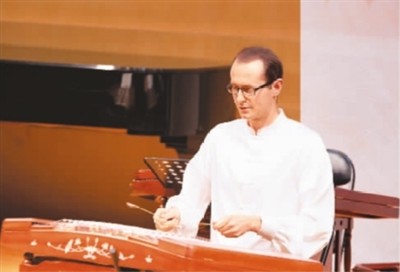Czech youth studying Chinese dulcimer
In the softly lit concert hall, the light and graceful dulcimer sound flowed like a mountain spring and flowed into the hearts of the audience. At the end of the song, the audience applauded and cheered incessantly. The melodious and lively "Good News", the elegant and tactful "Qinbalong Suite No. 2", and the "Jasmine Flower" with great oriental charm.

On January 6th, a meaningful concert was held at the Central Conservatory of Music. The first Chinese dulcimer international trainee of the Central Conservatory of Music, Ma Tai, a young Czech dulcimer performer, reported his study in China to people from all walks of life inside and outside the school. The latest achievements in Chinese dulcimer performance.
Since the age of 8, Ma Tai has studied under the chairman of the Czech Chimbalon (that is, the European dulcimer) Association, Professor Rugena Jetska, and later obtained an associate degree in Chimbaro from the Czech Janacek Conservatory of Music. In 2018, he was admitted to Northern State University in the United States and became the first Chinbarong student in an American university. He has successively won the first prize for solo solo and the special jury award in the highest age group at the 2017 Czech International Chinbarong Art Festival, and the 2021 International Chinbaron Art Festival. The first prize of the second prize of the Barong Art Festival (the first prize is vacant) and the special jury award and other important European competition awards.
Dulcimer is a stringed musical instrument that originated in the Middle East. It was introduced to China from Persia in the Ming Dynasty and localized as a national musical instrument in China. Dulcimer is widely distributed in the world and has different names. Chinbarong is the name of Eastern Europe and other countries. Chinese dulcimer and chinbarong have many differences in shape, technique and musical style. The Qinbalong is larger than the Chinese dulcimer, and its hammers mostly use wooden hammers, while the Chinese dulcimer uses bamboo, which also makes the two different in tone.
During his studies in the United States, Ma Tai came up with the idea of coming to China. Affected by the new crown pneumonia epidemic, Ma Tai's school's courses have been changed to online, so he has more time to communicate with friends. During a conversation, when Ma Tai's good friend praised his performance, he suggested that he could go to China to study and communicate. This sentence touched Ma Tai, and he began to learn Chinese, looking for the connection between Chinbarong and Chinese dulcimer, and at the same time always looking out for opportunities to study in China.
In September 2021, with the support of the Chinese Foreign Language Exchange and Cooperation Center of the Ministry of Education of China, Ma Tai came to the Central Conservatory of Music and studied under the Confucius Institute Office of the Central Conservatory of Music and the Director of the International Time and Research Base for Music, and a doctoral tutor for dulcimer majors. Professor Liu Yuening. During the 5-month training, Ma Tai took all the time to study hard. His profound musical skills allowed him to quickly master the playing skills of Chinese dulcimer, and learned "Spring to Qingjiang", "General's Order" and "Tanci Rhyme". and other works.
"It's more melodic than any music I've stumbled across before because it's so closely related to Chinese history and culture, and the pentatonic tones used in Chinese music is a system that suits me very well, and when I play these pieces, it's very helpful to me. Very inspiring." Mattai said.
In addition to Chinese dulcimer, Ma Tai has also studied Chinese, calligraphy, history of international communication of Chinese music and other related courses. In the daily interaction with the school teachers and classmates, they will also actively introduce Czech culture to Chinese teachers and students.
Liu Yuening was very moved by his hard work, "Ma Tai is a young Czech performer who loves Chinese music and culture. He gets up at 5 o'clock every morning to practice the piano, and at the same time, he is also working hard for the HSK (Chinese Proficiency Test) ). He is very sensitive to Chinese characters and can sometimes correct others' mistakes. I think this is the power of culture, the power of music, which enables us to communicate and learn from each other between civilizations."
During his time in China, Ma Tai showed a strong interest in Chinese culture, "I don't know much about China yet, although I have experience in learning Chinese and calligraphy, it is a long journey to understand Chinese language, Chinese history, and Chinese music. The process, it's been an exciting road full of surprises and explorations that I couldn't have done in 5 months. Hope to be here again in the future."
The Confucius Institute for Music at the Central Conservatory of Music and its base have been committed to cultivating overseas Chinese music experts for nearly 10 years. "This time Ma Tai came to study Chinese dulcimer as an international trainee, which is just the beginning. In the future, more international students will come to China to study Chinese national musical instruments and excellent traditional Chinese culture." Liu Yuening said. She believes that in order for Chinese music culture to have broad resonance and influence around the world, it is necessary to cultivate more foreign musicians like Ma Tai who have considerable professional standards and love China, as well as new communication and exchanges. As a successful example, Ma Tai also provided more ideas for future international educational exchanges.
 渝公网安备 50010702504639号
渝公网安备 50010702504639号